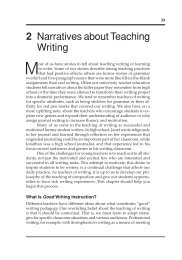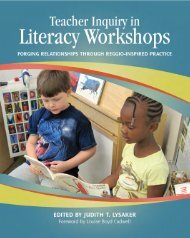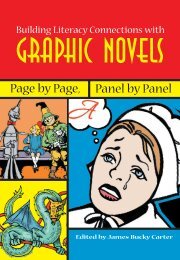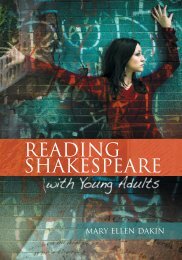Wood_cover.qxd (Page 1) - National Council of Teachers of English
Wood_cover.qxd (Page 1) - National Council of Teachers of English
Wood_cover.qxd (Page 1) - National Council of Teachers of English
- No tags were found...
Create successful ePaper yourself
Turn your PDF publications into a flip-book with our unique Google optimized e-Paper software.
82 Chapter 4Internet Note: The Exploratorium Memory Exhibition Web site thatstudents were introduced to earlier has several features that will assistthem in their projects. Besides having a diagram <strong>of</strong> the brain with descriptions<strong>of</strong> different parts relating to memory, the site also includes “LectureSeries Webcasts” about a range <strong>of</strong> memory-related topics such ashow stress affects memory and how children’s memories are differentfrom adults’ memories. Students will also enjoy playing with Droodles,a combination <strong>of</strong> riddles and doodles, to test their own memories.Classroom Snapshot: When I taught this lesson, I required that studentsincorporate Li-Young Lee’s poem “Mnemonic” into their products.For some students this worked well, and for others it was frustrating.One group sculpted a brain out <strong>of</strong> clay and, instead <strong>of</strong> just labelingthe parts <strong>of</strong> the brain, they also included different stanzas fromthe poem to show where in the brain these memories were stored.This was a creative and successful project, but another group decidedto act out a public service announcement about stress-related memoryloss, and they could not find a good way to integrate the poem intotheir idea. It turned out that the groups whose products were informationalhad the most trouble including “Mnemonic,” but most studentswho chose creative or personal products were able to incorporatethe poem. My greatest concerns were that students understandboth the poem and what we had studied about memory, but since“Mnemonic” was discussed thoroughly before students started workingon their projects, I felt assured that both <strong>of</strong> these goals were met.ExtensionOrganize a Memory FairIn the spirit <strong>of</strong> making projects like this one as authentic as possible,give your students an audience by helping them organize a memoryfair. Like a science fair, students can set up their projects in the gym oranother open space in your school and prepare to present their work,answering questions about the brain, memory, and how Li-Young Lee’s“Mnemonic” applies to what they have produced. Have students collaboratewith one another to find classmates who have made things thatconnect with one another. For example, one group may have made aPowerPoint presentation about how children remember things whileanother group conducted memory tests with younger siblings. Putting
















